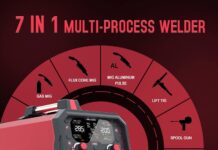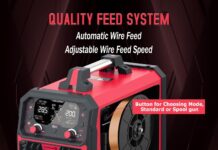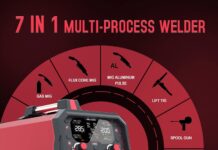If you’re a welder, you know protecting yourself from heat, sparks, and fumes is essential.
It’s not only crucial for your safety but also your productivity as a professional welder. The proper respirator helmet can help you do both. This article discusses the different types of welding respirator helmets and what to look for when choosing one.
We will also discuss how a respirator helmet protects welders from dangerous smoke inhalation and other welding-related health hazards.
By the end of this article, you should have all the information necessary to decide which respirator helmet is best for your work.
What is a Respirator Helmet?
Most people associate “welding” and “helmet” with the classic welding helmet.
This type of headgear covers the face and has a glass window in the front through which the welder can see his work.
However, welders may use another type of helmet: the respirator helmet.
A respirator helmet looks similar to a regular welding helmet but has an attached air filtration system. This system helps to filter out harmful fumes and particles that welding produces.
The air filtration system consists of a cartridge or canister that contains activated carbon. The cartridge or canister filters out harmful fumes and particles as the air passes through it.
Welders who work in environments with high fumes or particles may be required to wear a respirator helmet.
Some welding jobs may also require using a respirator helmet even if not high levels of fumes or particles are present.
For example, welders may need to wear a respirator helmet when welding stainless steel because stainless steel produces harmful chromium fumes.
If you are a welder, it is essential to know whether or not you will need to wear a respirator helmet for your job. If you are unsure, you should ask your employer or safety representative.
YESWELDER Powered Air Purifying Respirator Auto Darkening Welding Helmet M800H
Miller ML00895 Lpr-100 Respirator W/Filters, Medium/Large by Miller Electric
Rsenr Electric Wearable Air Purifier Maskes,Air Supply,Breathe Easier,With HEPA Filter,for Dust Work,Painting, Machine Polishing, Welding and Other Work Protection…
The Benefits of Wearing a Respirator Helmet
When it comes to welding, one of the essential pieces of equipment you can have is a respirator helmet.
A respirator helmet protects your lungs from the harmful fumes and particles produced when welding.
Many types of respirator helmets are available on the market, so it is essential to choose one that is right for you.
Some of the factors you should consider when selecting a respirator helmet include the following:
- The welding you will be doing: There are different types of welding, such as arc welding and gas welding. Each type of welding produces various types of fumes and particles. You will need to choose a respirator helmet designed for the kind of welding you will be doing.
- The size of your head: Respirator helmets come in different sizes. It is essential to choose a respirator helmet that fits your head snugly to protect your lungs adequately.
- Your budget: Respirator helmets can range from around $50 to over $500. Setting a budget before you start shopping is essential so you don’t overspend on this crucial safety equipment.
How to Choose the Right Respirator Helmet
There are a few things to consider when choosing the fitting respirator helmet for welding. The first is the type of welding you will be doing.
If you are doing gas welding, you will need a different helmet than if you are doing arc welding. The second thing to consider is the amount of protection you need.
Some helmets have a face shield that covers only your eyes, while others have a full face shield that protects your entire face. The third thing to consider is the price.
Helmets can range in price from a few hundred dollars to over a thousand dollars. Choose the one that fits your budget and needs.
Read Next – Best Welding Helmets 2023- Review And Buying Guide
Why do welders need respirator helmets?
Welding is a process that produces harmful fumes and particles that the welder can inhale. Inhaling these fumes and particles can lead to serious health problems, including lung cancer.
Respirator helmets protect welders from inhaling these harmful fumes and particles.
Respirator helmets have filters that remove toxic fumes and particles from the air before the welder inhales them.
Respirator helmets are an essential part of a welder’s protective equipment. Welders should always wear a respirator helmet to protect their lungs from the harmful fumes and particles produced by welding.
Read Next – Respiratory Hazards of Aluminum Welding
What are the dangers of welding?
Welding is a process that uses high heat to melt and join together metal parts. The welder then uses a filler material to join the two pieces of metal together.
Welding can be dangerous because it produces harmful fumes and ultraviolet (UV) rays that can damage your eyes and skin.
The most common welding dangers are:
- Fumes: Welding produces harmful fumes that can contain metals and chemicals. These fumes can be toxic if breathed in.
- Ultraviolet radiation: Welding also produces UV rays that can damage your eyes and skin. It is essential to wear protective gear, such as a welding helmet when welding.
- Fire: Welding sparks can cause fires if they land on flammable materials. It is essential to have a fire extinguisher nearby when welding.
- Electric shock: Electric shock can occur if you touch an electrically charged part of the welder while the power is turned on. Always turn off the power before connecting any part of the welder.
YESWELDER Powered Air Purifying Respirator Auto Darkening Welding Helmet M800H
Miller ML00895 Lpr-100 Respirator W/Filters, Medium/Large by Miller Electric
Rsenr Electric Wearable Air Purifier Maskes,Air Supply,Breathe Easier,With HEPA Filter,for Dust Work,Painting, Machine Polishing, Welding and Other Work Protection…
Read Next – What is the Best Welding Helmets Canada in 2023
What are the different types of respirator helmets?
Welders can choose from many types of respirator helmets, depending on their specific needs.
The most common type of helmet is the full-face respirator, which covers the entire face and protects the wearer from harmful fumes and gases.
Other helmets include half-face respirators, which only cover the nose and mouth, and quarter-face respirators, which only cover the mouth.
There are also powered air-purifying respirators (PAPRs), which use a battery-powered fan to circulate fresh air through the helmet, and self-contained breathing apparatus (SCBAs), which provide oxygen supply.
Read Next – Top 5 Best Welding Tools Mig in 2024
Tips for Using a Respirator Helmet
When welding, it is essential to wear a respirator helmet to protect your lungs from harmful fumes.
Here are some tips for using a respirator helmet:
- Make sure that the helmet fits snugly and that there are no gaps between the helmet and your face.
- Check that the filters are clean and replaced regularly.
- Store the respirator helmet in a clean, dry place when not in use.
What respirator to use for welding?
When welding, using the correct respirator helmet is essential to protect yourself from harmful fumes.
Many different types of welding helmets are available on the market, so it is necessary to do your research to find the one that best suits your needs.
The most common type of welding helmet is the half-mask respirator. This type of respirator covers your nose and mouth and has a filter that protects you from inhaling harmful fumes. Half-mask respirators are typically used for light weldings, such as soldering or working with small metal objects.
If you are doing a more intensive welding job, such as working with large pieces of metal or using power tools, you will need to use a full-face respirator.
This type of respirator covers your entire face and has a more robust filter to protect you from harmful fumes. Full-face respirators are also equipped with a shield to protect your eyes from the bright flashes of light produced during welding.
Consistently ensures that it fits snugly and comfortably on your head, regardless of the type of welding helmet you choose. You should also replace the filter regularly to ensure you are always protected from harmful fumes.
How do you stop inhaling welding fumes?
Using a respirator helmet is essential to prevent inhaling welding fumes. But what do you do if you accidentally inhale welding fumes?
If you feel lightheaded or dizzy after inhaling welding fumes, removing yourself from the area immediately and getting some fresh air is essential. If you have access to an oxygen tank, use it. If possible, try to stay calm and avoid any physical activity.
If you experience difficulty breathing, chest pain, or other severe symptoms, call 911 and go to the nearest emergency room.
What are the two types of welder masks?
Welding is joining two materials by heating them to their melting point and then cooling them to solidify. The welder uses an electric arc to create the heat to melt the metals.
The filler material is then added to the joint, and the welder must be protected from the intense light and heat generated by the arc.
There are two types of welding masks: auto-darkening and passive. Auto-darkening welding masks have a filter that darkens when exposed to the bright light of the arc, protecting the welder’s eyes from being blinded.
Passive welding masks have a fixed shade lens that does not change when exposed to the arc. Both covers protect the welder’s face and eyes from sparks, splashes, and ultraviolet (UV) radiation.
Can I wear a respirator under the welding helmet?
Yes, you can wear a respirator under your welding helmet. You may need to adjust your helmet’s fit to accommodate the respirator, but it is possible.
It is essential to ensure that the seal on the respirator is good and that there are no gaps between the helmet and the respirator.
YESWELDER Powered Air Purifying Respirator Auto Darkening Welding Helmet M800H
Miller ML00895 Lpr-100 Respirator W/Filters, Medium/Large by Miller Electric
Rsenr Electric Wearable Air Purifier Maskes,Air Supply,Breathe Easier,With HEPA Filter,for Dust Work,Painting, Machine Polishing, Welding and Other Work Protection…
Can you get arc eye through a welding mask?
Yes, you can get arc eye through a welding mask. The UV radiation from the welding arc can damage your eyes and cause vision problems.
Wearing a welding helmet with a proper lens approved for use with welding equipment is essential.
Conclusion
We hope this article has provided helpful information on the importance of a welder wearing a respirator helmet.
These helmets protect welders from potential health risks associated with welding fumes and other particles. With an array of options available, it’s necessary to research and finds the suitable model for your needs before taking on any welding job.
Safety should always be prioritized when working with hazardous materials, so take all necessary precautions when getting started as a welder!
3M Speedglas Heavy-Duty Welding Helmet G5-01 w ADF G5-01 and 3M Adflo High-Altitude PAPR Assembly, 46-1101-30i
YESWELDER Powered Air Purifying Respirator Auto Darkening Welding Helmet M800H
3M Speedglas Heavy-Duty Welding Helmet G5-01 w 3M Adflo High-Altitude PAPR Assembly, No ADF, 46-1101-00
3M Speedglas Welding Helmet 9100 Air with Welding Kit Auto Darkening Filter 9100XXi and 3M Adflo Powered Air Respirator, 35-1101-30isw, Compact, Lightweight Respiratory Protection, Memory Modes
Miller ML00895 Lpr-100 Respirator W/Filters, Medium/Large by Miller Electric
Rsenr Electric Wearable Air Purifier Maskes,Air Supply,Breathe Easier,With HEPA Filter,for Dust Work,Painting, Machine Polishing, Welding and Other Work Protection…
Lincoln Electric XLR P100 Half Mask Respirator - Small
Half Mask Respirator, S/M, Single Filter
Secure Click 3M Respirator, Half Face Reusable Respirator with Speaking Diaphragm and Push Button Seal Check, HF-802SD, Sweeping, Sanding, Grinding, Sawing, Dust, Medium
$50.98 in stock
GVS SPR457 Elipse P100 Dust Half Mask Respirator with replaceable and reusable filters included, blue, m/l size
$40.27 in stock
Reusable Half Face Cover M308 with 2091 Filter, Protective Equipment Widely used in Welding, Painting, Decorating Carpentry, Metal Cutting, Same Scene as 6000 6200 7000 FF-400
Q: Why do welders need a respirator helmet?
A: Welders are exposed to harmful gases, fumes, and particles during welding. A respirator helmet provides respiratory protection and protects the user from these hazards.
Q: What are the benefits of a powered air purifying respirator (PAPR)?
A: A PAPR provides filtered air to the user using a battery-powered blower to draw air through a filter. This system provides the worker with a constant clean air flow and reduces breathing resistance. It is also lightweight and allows for greater mobility and comfort.
Q: What is the difference between a powered air purifying respirator (PAPR) and a supplied air respirator (SAR)?
A: A PAPR uses a powered blower to draw air through a filter, while a SAR delivers clean air through a hose connected to an air source. Both provide respiratory protection, but a PAPR allows greater mobility as no hose restricts movement.
Q: What should I consider when choosing a respirator helmet?
A: You should consider the type of welding you will be doing, the job duration, the potential hazards present, the working conditions, and the level of comfort required. Choosing a respirator helmet that meets the assigned protection factor (APF) required by OSHA is essential.
Q: What are the product details of a respirator helmet?
A: A respirator helmet typically consists of a hood, a visor or viewing assembly, and a filtration system. The hood covers the head and neck, and the visor or viewing assembly provides a clear view of the work. Depending on the model, the filtration system can be a PAPR or a SAR.
Q: What is a shroud in a respirator helmet?
A: A shroud is a flexible tube that connects the hood of a respirator helmet to the filtration system or air source. It allows clean air to be directed toward the user’s breathing zone.
Q: What is the maintenance required for a respirator helmet?
A: The maintenance required for a respirator helmet depends on the model and manufacturer. However, cleaning the respirator helmet after each use and replacing parts as recommended by the manufacturer to ensure proper respiratory protection is essential.
Q: What is the significance of the 3M™ brand in respirator helmets?
A: 3M™ is a leading manufacturer of respiratory protection products, including PAPRs and SARs. Their products are known for their high quality and filtration efficiency, making them a trusted supplier of respiratory solutions.
Q: What is a hood in a respirator helmet?
A: A hood is part of a respirator helmet that covers the head and neck of the user. It is typically made of flame-resistant materials and can be coated with polycarbonate or other materials for added durability.
Q: What is a visor in a respirator helmet?
A: A visor is part of a respirator helmet that provides a clear view of the work. It can be a full-face visor, a tube for viewing, or other viewing assemblies.
Q: What is a supplied air respirator (SAR)?
A: A SAR delivers clean air to the user through a hose connected to an air source. It provides respiratory protection similar to a PAPR but has a hose restricting movement. SARs are typically used when the air source is nearby and mobility is not required.

















































